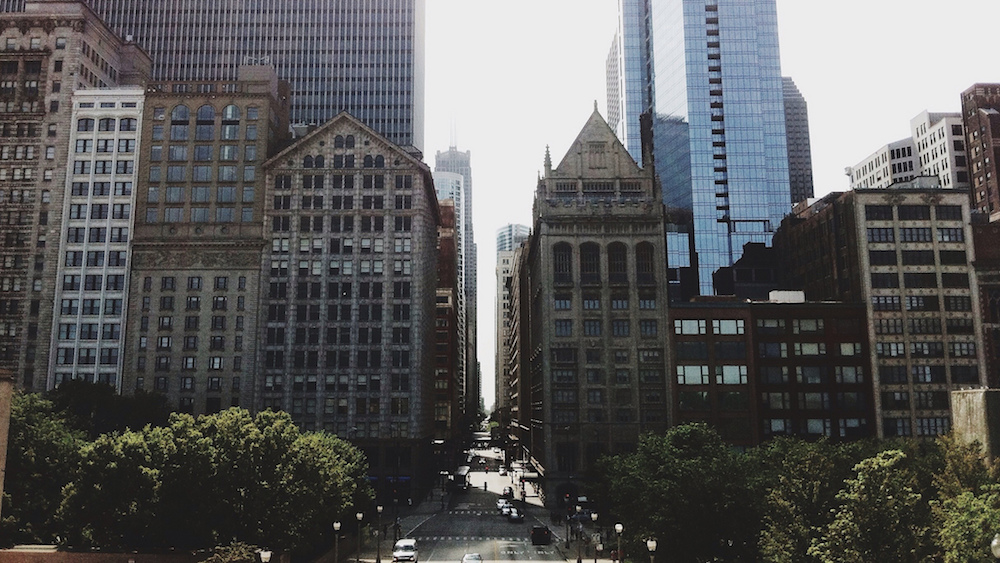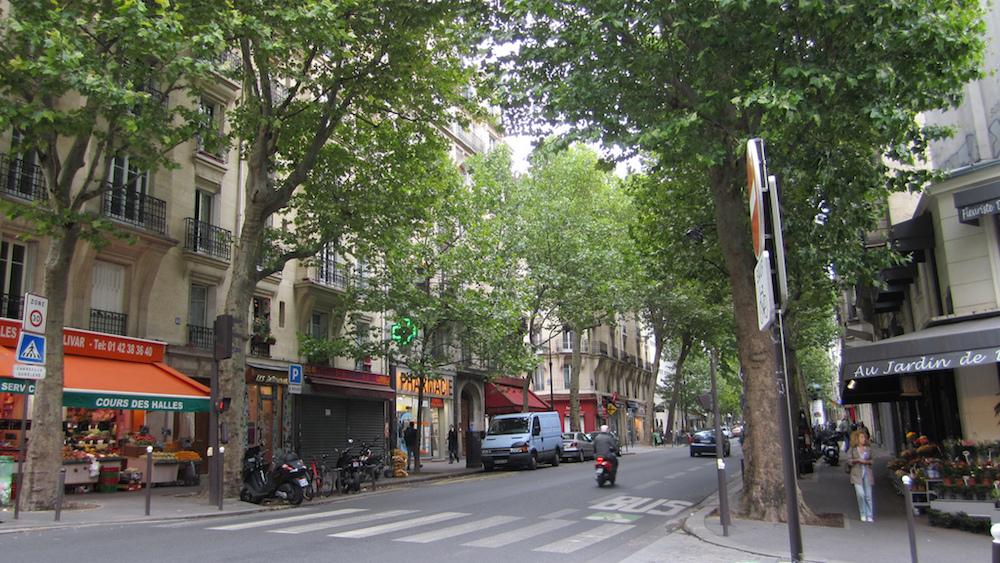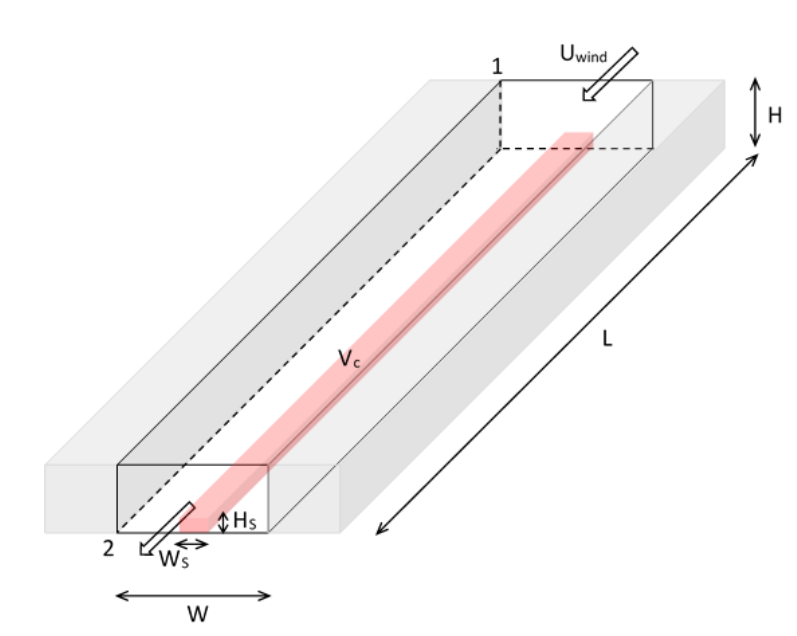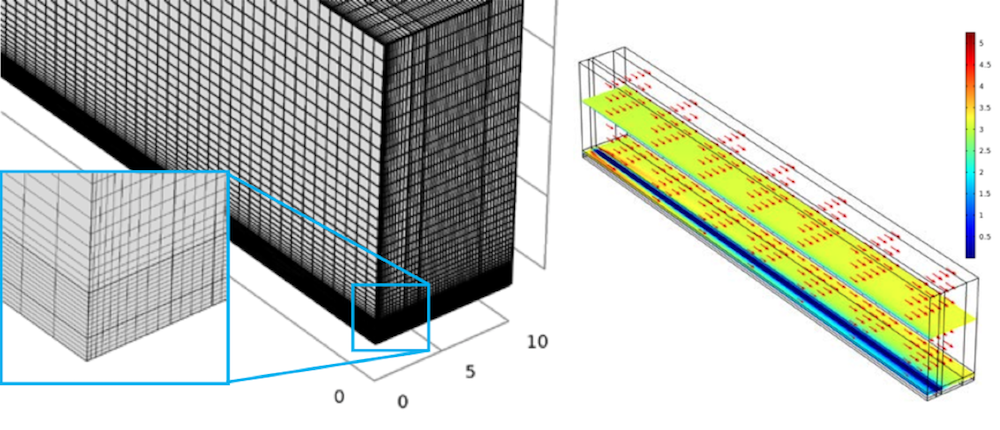
When looking to mitigate air pollution, a major health concern in many highly populated cities, one option is to use plants and greenery. Before this method can be used, it’s important to confirm that this technique is a functional strategy for improving air quality and determine the best way of implementing it. To accomplish this, researchers created a model in the COMSOL Multiphysics® software to see how different types of greenery affect pollution reduction in urban canyons.
Planting the Seeds for Improved Air Quality in Urban Canyons
Have you ever walked down a city street and felt dwarfed by the tall buildings around you, as if you were walking through an artificial ravine or canyon? Well, this type of environment has a name: an urban (or street) canyon. An urban canyon occurs when a street is surrounded by tall buildings on both sides, creating an environment similar to that of a canyon.

The entrance to an urban canyon. Image by Kanwar Sandhu — Own work. Licensed under CC BY-SA 2.0, via Flickr Creative Commons.
In many of the highly populated areas that these canyons exist, air pollution is a large problem. According to the World Health Organization (WHO), more than 80% of the people living in urban areas that monitor air pollution are subjected to air quality levels exceeding WHO limits. Such poor air quality can lead to a variety of health issues for city dwellers. To combat this issue, there is a need for urban planning and design strategies that focus on reducing air pollution and restoring air quality. One possible method is adding vegetation and greenery to urban canyons.

Trees along a city street. Image by La Citta Vita — Own work. Licensed under CC BY-SA 2.0, via Flickr Creative Commons.
Vegetation improves air quality by absorbing and retaining fine dust particles and gaseous pollutants, affecting pollutant deposition and dispersion. Adding greenery to urban canyons has other benefits, such as improving building energy performance, reducing the heat island effect of cities, and managing stormwater runoff. In addition, such greenery can be aesthetically pleasing.
While recent studies have investigated using greenery in this manner, more information about its effectiveness and use is needed before we can give this technique the green light. For instance, vegetation’s size, shape, and the characteristics of individual plants (like leaf size and porosity) can all factor into its effectiveness.
Based on this need, researchers from the University of Genova and the University of Bologna performed a simulation study to see how greenery affects pollution reduction in a straight urban canyon. They also compared the effects of different types of greenery and wind velocity. Let’s take a look at their work.
Investigating the Effect of Plants on Urban Air Pollution with Simulation
The research team’s CFD model depicts a straight road — 20 m wide and 100 m long — that is surrounded on either side by a continuous line of buildings. These buildings, shown in light gray in the image below, are all 20 m tall. In their analysis, the team only needed to account for half of the geometry due to its symmetry.
Air flows into the model from an inlet section (labeled 1) and moves along the road’s main axis before exiting from the outlet section (labeled 2). To help focus on the reduction in pollution caused by the greenery, the incoming air is pollution free.

The geometry of the urban canyon model. Image by S. Lazzari, K. Perini, E. Rossi di Schio, and E. Roccotiello and taken from their COMSOL Conference 2016 Munich paper.
To further simplify their model, the researchers didn’t account for the disruptions that cars create in the fluid flow within an urban canyon. However, this does not mean that cars were ignored completely. As passenger vehicles are the main source of road pollution, the team’s study focuses on one major car pollutant: CO2. This pollutant is uniformly generated within the volume, Vc (depicted in red above), and transported via convection and diffusion. The volume, located in the middle of the road, has a width of 5 m and height of 0.5 m.
The plants are modeled as a Darcian porous medium that is saturated by air and able to absorb pollutants (diluted species). By changing the values of porosity and permeability as well as the reduction reaction, the team can tailor their model to a desired plant species. This flexibility enables them to easily study different plant species and shapes of greenery. In this study, for instance, they analyzed two different greenery shapes:
- Continuous green façade that is 0.3 m thick
- Continuous hedge that is 1.5 m tall and 1 m wide
In addition to these two geometries, a third geometry of a “clear” canyon — with pollution but without plants — is used for comparison.

Qualitative cross sections showing the geometries of a continuous green façade (left) and hedge (right). Images by S. Lazzari, K. Perini, E. Rossi di Schio, and E. Roccotiello and taken from their COMSOL Conference 2016 Munich paper.
Analyzing the Effect of Greenery Shape and Inlet Wind Velocity on Air Pollutant Concentration
Using this model, the team compared pollutant concentrations in the clear canyon, green façade, and green hedge for inlet velocities of 0.5 m/s and 3 m/s. The results are shown in the following tables.
| Plane 0.3 m from Ground | Plane 1 m from Ground | Canyon Outlet | Canyon Overall Volume | |
|---|---|---|---|---|
| Clear Canyon | 207.65 | 5.379 | 14.568 | 7.107 |
| Green Façade | 184.86 | 0.256 | 14.472 | 6.435 |
| Green Hedge | 189.87 | 0.272 | 15.765 | 6.868 |
The pollutant concentrations of the three geometries in mol/m3 for an inlet velocity of 0.5 m/s.
| Plane 0.3 m from Ground | Plane 1 m from Ground | Canyon Outlet | Canyon Overall Volume | |
|---|---|---|---|---|
| Clear Canyon | 34.127 | 0.791 | 2.537 | 1.244 |
| Green Façade | 27.471 | 0.00489 | 1.666 | 0.832 |
| Green Hedge | 26.862 | 0.00448 | 1.860 | 0.931 |
The pollutant concentrations of the three geometries in mol/m3 for an inlet velocity of 3 m/s.
The initial results indicate that greenery has a positive effect on reducing the overall pollution in an urban canyon and that (obviously) a faster wind speed also reduces the overall pollution volume. As for the two different plant types, the team found that the green façade is better at reducing pollution than the green hedge.

The mesh for the green hedge scenario (left) and the air velocity distribution for the green hedge scenario with a wind velocity of 3 m/s (right). Images by S. Lazzari, K. Perini, E. Rossi di Schio, and E. Roccotiello and taken from their COMSOL Conference 2016 Munich paper.
For these researchers, this analysis is the first of multiple studies of using greenery to enhance air quality in dense urban areas. In the future, the team intends to run more numerical and experimental investigations, including studying the trap effects of plants in an innovative chamber. With this experimental data, they hope to further improve their model.
Learn More About CFD Modeling in COMSOL Multiphysics®
- Read the full COMSOL Conference paper: “Simplified CFD Modeling of Air Pollution Reduction by Means of Greenery in Urban Canyons“
- Check out other blog posts related to CFD modeling:




Comments (0)